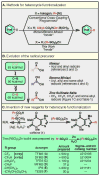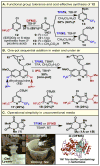Practical and innate carbon-hydrogen functionalization of heterocycles
- PMID: 23201691
- PMCID: PMC3518649
- DOI: 10.1038/nature11680
Practical and innate carbon-hydrogen functionalization of heterocycles
Abstract
Nitrogen-rich heterocyclic compounds have had a profound effect on human health because these chemical motifs are found in a large number of drugs used to combat a broad range of diseases and pathophysiological conditions. Advances in transition-metal-mediated cross-coupling have simplified the synthesis of such molecules; however, C-H functionalization of medicinally important heterocycles that does not rely on pre-functionalized starting materials is an underdeveloped area. Unfortunately, the innate properties of heterocycles that make them so desirable for biological applications--such as aqueous solubility and their ability to act as ligands--render them challenging substrates for direct chemical functionalization. Here we report that zinc sulphinate salts can be used to transfer alkyl radicals to heterocycles, allowing for the mild (moderate temperature, 50 °C or less), direct and operationally simple formation of medicinally relevant C-C bonds while reacting in a complementary fashion to other innate C-H functionalization methods (Minisci, borono-Minisci, electrophilic aromatic substitution, transition-metal-mediated C-H insertion and C-H deprotonation). We prepared a toolkit of these reagents and studied their reactivity across a wide range of heterocycles (natural products, drugs and building blocks) without recourse to protecting-group chemistry. The reagents can even be used in tandem fashion in a single pot in the presence of water and air.
Conflict of interest statement
The authors declare no competing financial interests. Supplementary Information and chemical compound information accompany this paper at
Figures


Comment in
-
Organic chemistry: Toolkit of reagents to aid drug discovery.Nature. 2012 Dec 6;492(7427):45-6. doi: 10.1038/nature11760. Epub 2012 Nov 28. Nature. 2012. PMID: 23201687 No abstract available.
Similar articles
-
Direct functionalization of nitrogen heterocycles via Rh-catalyzed C-H bond activation.Acc Chem Res. 2008 Aug;41(8):1013-25. doi: 10.1021/ar800042p. Epub 2008 Jul 11. Acc Chem Res. 2008. PMID: 18616300 Free PMC article. Review.
-
Bidentate, monoanionic auxiliary-directed functionalization of carbon-hydrogen bonds.Acc Chem Res. 2015 Apr 21;48(4):1053-64. doi: 10.1021/ar5004626. Epub 2015 Mar 10. Acc Chem Res. 2015. PMID: 25756616 Free PMC article.
-
Late-stage oxidative C(sp3)-H methylation.Nature. 2020 Apr;580(7805):621-627. doi: 10.1038/s41586-020-2137-8. Epub 2020 Mar 16. Nature. 2020. PMID: 32179876 Free PMC article.
-
Direct arylation of strong aliphatic C-H bonds.Nature. 2018 Aug;560(7716):70-75. doi: 10.1038/s41586-018-0366-x. Epub 2018 Aug 1. Nature. 2018. PMID: 30068953 Free PMC article.
-
Catalytic C-H functionalization by metal carbenoid and nitrenoid insertion.Nature. 2008 Jan 24;451(7177):417-24. doi: 10.1038/nature06485. Nature. 2008. PMID: 18216847 Free PMC article. Review.
Cited by
-
Organoborohydride-catalyzed Chichibabin-type C4-position alkylation of pyridines with alkenes assisted by organoboranes.Chem Sci. 2020 Sep 29;11(42):11554-11561. doi: 10.1039/d0sc04808a. Chem Sci. 2020. PMID: 34094401 Free PMC article.
-
Preparation and purification of zinc sulfinate reagents for drug discovery.Nat Protoc. 2013 Jun;8(6):1042-7. doi: 10.1038/nprot.2013.059. Epub 2013 May 2. Nat Protoc. 2013. PMID: 23640168 Free PMC article.
-
Direct heterobenzylic fluorination, difluorination and trifluoromethylthiolation with dibenzenesulfonamide derivatives.Chem Sci. 2018 Jun 7;9(25):5608-5613. doi: 10.1039/c8sc01221k. eCollection 2018 Jul 7. Chem Sci. 2018. PMID: 30061993 Free PMC article.
-
C-H Bond Functionalization of N-Heteroarenes Mediated by Selectfluor.Top Curr Chem (Cham). 2023 Sep 22;381(5):29. doi: 10.1007/s41061-023-00437-6. Top Curr Chem (Cham). 2023. PMID: 37736818 Review.
-
Radical addition to iminium ions and cationic heterocycles.Molecules. 2014 Oct 10;19(10):16190-222. doi: 10.3390/molecules191016190. Molecules. 2014. PMID: 25310148 Free PMC article. Review.
References
-
- Minisci F, Vismara E, Fontana F. Recent developments of free-radical substitutions of heteroaromatic bases. Heterocycles. 1989;28:489–519.
-
- Duncton MAJ. Minisci reactions: versatile CH-functionalizations for medicinal chemists. Med Chem Comm. 2011;2:1135–1161.
Publication types
MeSH terms
Substances
Grants and funding
LinkOut - more resources
Full Text Sources
Other Literature Sources

